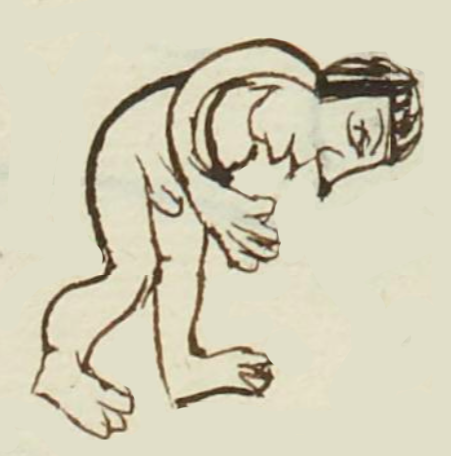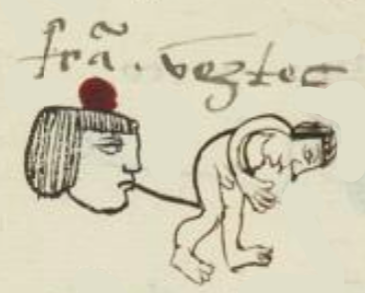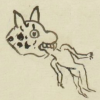Huetztoc (MH843r)
This black-line drawing of the simplex glyph for the personal name Huetztoc (“He Lies Fallen”) is attested here as a man’s name. The glyph shows a man in profile, facing the viewer’s right. His nose and upper lip seem to have been painted a bit long, and those tips have been crossed out. He only has three toes showing on each foot; this might be intentional, to suggest that he is alterabled. The upper part of his body is hunched over. He is naked, and his penis is visible (something rare). Perhaps he has tripped, and he is falling (hence the verb, huetztoc, fallen or stretched out).
Stephanie Wood
Two other examples of the verb huetztoc appear below. All of these examples involve a person who is nude, as though being nude was a vulnerable state that might coincide with falling.
Stephanie Wood
fraco vetztoc
Francisco Huetztoc
Stephanie Wood
1560
Jeff Haskett-Wood
desnudez, deznudo, cuerpo humano, peine, caído, nombres de hombres

huetztoc, stretched out or fallen, https://nahuatl.wired-humanities.org/content/huetztoc
huetzi, to fall down, https://nahuatl.wired-humanities.org/content/huetzi
-toc, to be lying down, https://nahuatl.wired-humanities.org/content/toc-1
Caído
Stephanie Wood
Matrícula de Huexotzinco, folio 843r, World Digital Library, https://www.loc.gov/resource/gdcwdl.wdl_15282/?sp=760&st=image.
This manuscript is hosted by the Library of Congress and the World Digital Library; used here with the Creative Commons, “Attribution-NonCommercial-ShareAlike 3.0 License” (CC-BY-NC-SAq 3.0).








